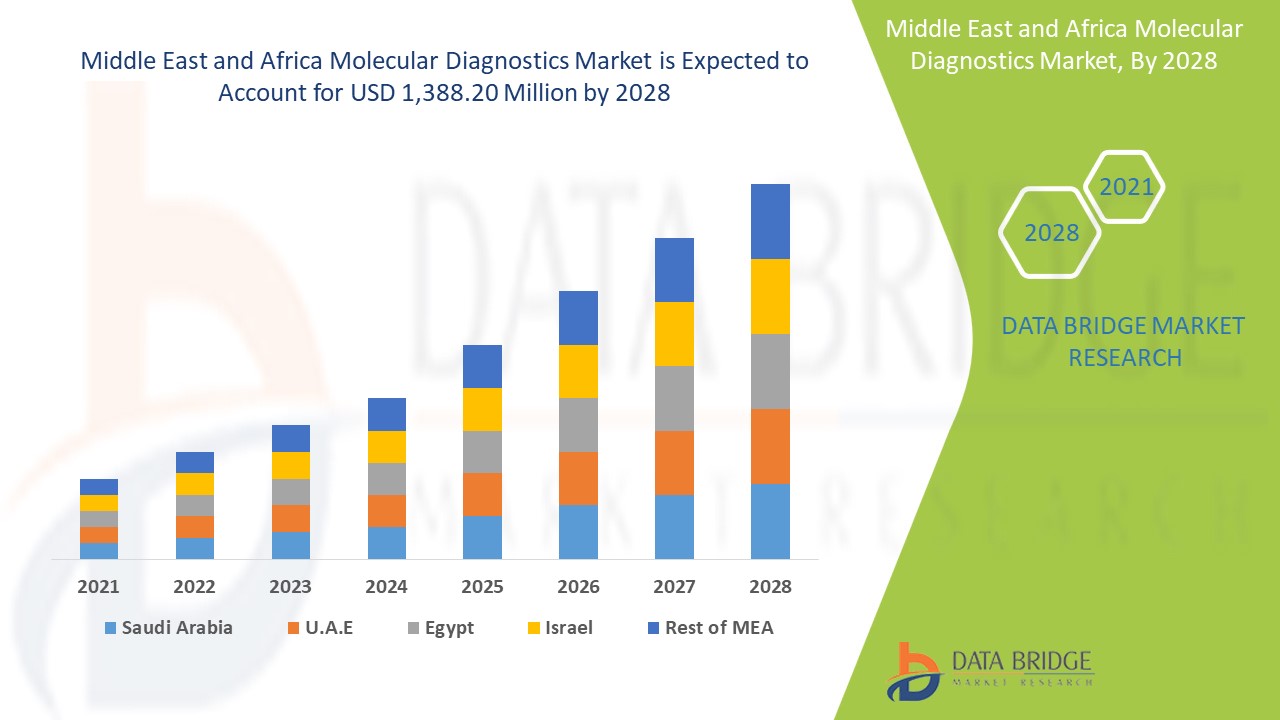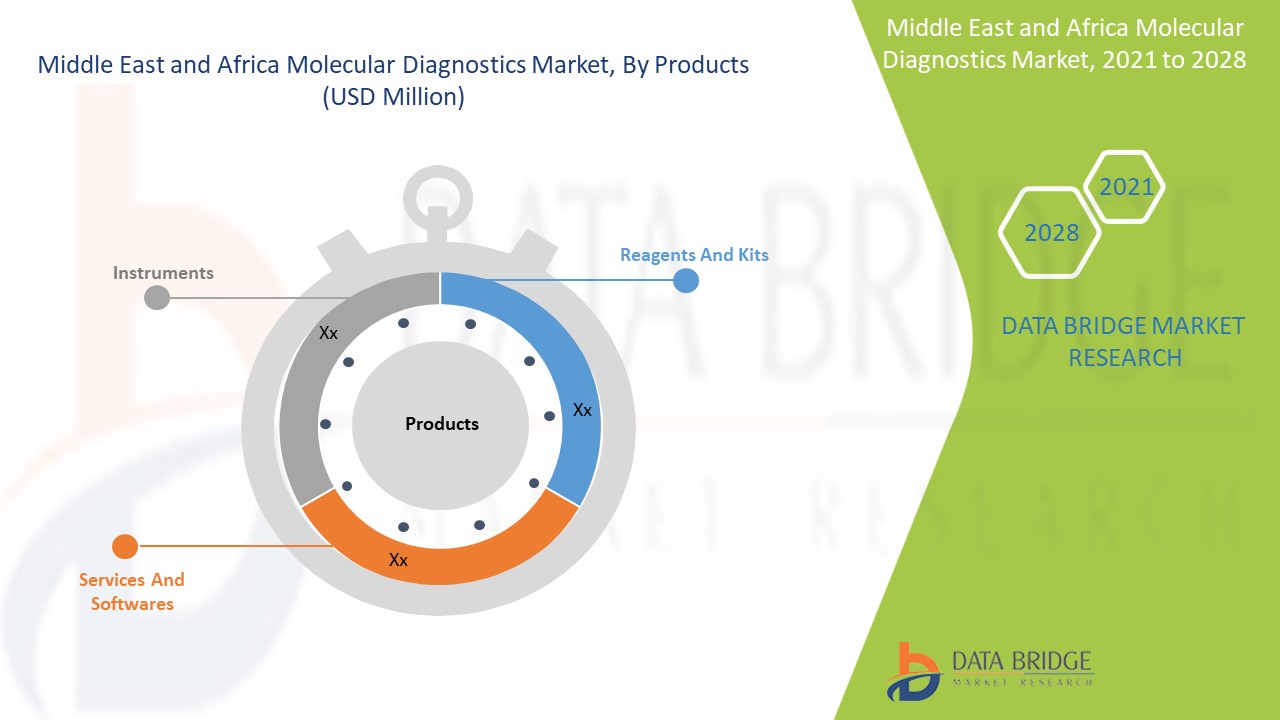Middle East & Africa Molecular Diagnostics Market, By Products (Reagents & Kits, Instruments and Services & Softwares), Technology (Mass Spectrometry (MS), Capillary Electrophoresis, Next Generation Sequencing (NGS), Chips and Microarray, Polymerase Chain Reaction (PCR)-Based Methods, Cytogenetics, In Situ Hybridization (ISH or FISH), Molecular Imaging and Others), Application (Oncology, Pharmacogenomics, Microbiology, Prenatal Tests, Tissue Typing, Blood Screening, Cardiovascular Diseases, Neurological Diseases, Infectious Diseases, and Others), End User (Hospital, Clinical Laboratories, and Academics), Country (South Africa, and Rest Of Middle East And Africa) Industry Trends And Forecast to 2028.

Market Analysis and Insights: Middle East and Africa Molecular Diagnostics Market

The molecular diagnostics market is expected to gain market growth in the forecast period of 2021 to 2028. Data Bridge Market Research analyses that the market is growing with a CAGR of 6.1% in the forecast period of 2021 to 2028 and is expected to reach USD 1,388.20 Million by 2028. The demand for molecular diagnostics tools is increasing to diagnose COVID-19 patients, coupled with an increase in infectious disease and cancer prevalence as a drivers for the molecular diagnostics market growth.
Molecular diagnosis identifies or diagnoses diseases such as infectious diseases, genetic diseases, cardiovascular diseases, neurological diseases, and others by studying molecules such as DNA, RNA, protein in a tissue or a fluid. Different technologies such as PCR, mass spectrometry, next-generation sequencing, cytogenetics, in situ hybridization, molecular imaging, and others are used to diagnose different diseases. Molecular diagnostics use powerful tools such as gene expression profiling, DNA sequence analysis, and detection of biomarkers to determine the susceptibility of individuals to certain diseases or existing disease stage. It has become an important part of hospitals, clinical laboratories, and others as it includes all the tests and methods to identify a disease and analyze it. It helps offer the best treatment to the patients, and with new technologies, the diagnostics process has become faster and more efficient.
Molecular diagnostics tools, instruments, and kits are developed to diagnose a particular or multiple diseases from body fluid or tissues. Many technological developments are launching new products with highly efficient technology to offer the best possible treatment on time. Moreover, the demand for molecular diagnostics tools increases to diagnose COVID-19 patients, coupled with an increase in infectious disease and cancer prevalence. Increasing demand for point-of-care testing is the key factor driving the Middle East & Africa molecular diagnostics market. However, the high cost of instrumentation and stringent rules laid down by governmental bodies for the approval of molecular diagnostics products may hamper the growth of the molecular diagnostics market.
Furthermore, the rise in several fundings by governmental bodies and private authorities to develop molecular diagnostics products coupled with increased healthcare expenditure and rising adoption of analyzer software for molecular diagnostics will create huge opportunities for the Middle East & Africa Molecular Diagnostics market. However, high competition in the market and disturbed supply chain due to the COVID-19 pandemic are expected to challenge the Middle East & Africa molecular diagnostics market.
The molecular diagnostics market report provides details of market share, new developments, and product pipeline analysis, impact of domestic and localised market players, analyses opportunities in terms of emerging revenue pockets, changes in market regulations, product approvals, strategic decisions, product launches, geographic expansions, and technological innovations in the market. To understand the analysis and the Molecular diagnostics market scenario contact Data Bridge Market Research for an Analyst Brief, our team will help you create a revenue impact solution to achieve your desired goal.

Molecular Diagnostics Market Scope and Market Size

The molecular diagnostics market is segmented based on the products, technology, application, and end user. The growth among segments helps you analyse niche pockets of growth and strategies to approach the market and determine your core application areas and the difference in your target markets.
- On the basis of products, the Middle East & Africa molecular diagnostics market is segmented into reagents & kits, instruments and services & softwares. Instruments are further segmented into fully automated instruments and semi-automated instruments. In 2021, the instruments segment is expected to dominate the molecular diagnostics market due to the rise in demand for advanced technology to diagnose diseases like infectious diseases, cancer, and others.
- On the basis of technology, the Middle East & Africa molecular diagnostics market is segmented into mass spectrometry (MS), capillary electrophoresis, next generation sequencing (NGS), chips and microarray, polymerase chain reaction (PCR)-based methods, cytogenetics, in situ hybridization (ISH or FISH), molecular imaging and others. The polymerase chain reaction (PCR)-based methods are further segmented into cold PCR, digital PCR, directlinear analysis, quantitative fluorescent PCR, real-time PCR and reverse transcriptase PCR. The molecular imaging segment is further subdivided into optical imaging and FDG-PET. In 2021, the polymerase chain reaction (PCR)-based methods segment is expected to dominate the molecular diagnostics market due to increased demand for PCR kits to diagnose COVID-19 and curb the pandemic.
- On the basis of application, the Middle East & Africa molecular diagnostics market is segmented into oncology, pharmacogenomics, microbiology, prenatal tests, tissue typing, blood screening, cardiovascular diseases, neurological diseases, infectious diseases, and others. The oncology segment is further segmented into oncology, by cancer type, and oncology, by technology. The oncology, by cancer type is further sub-divided into breast cancer, colorectal cancer, lung cancer, prostate cancer, and others. The oncology, by technology, is further sub-segmented into mass spectrometry (MS), capillary electrophoresis, next generation sequencing (NGS), chips and microarray, polymerase chain reaction (PCR)-based methods, cytogenetics, in situ hybridization (ISH or FISH), molecular imaging and others. The pharmacogenomics is further segmented into mass spectrometry (MS), capillary electrophoresis, next generation sequencing (NGS), chips and microarray, polymerase chain reaction (PCR)-based methods, cytogenetics, in situ hybridization (ISH or FISH), molecular imaging and others. The microbiology is further segmented into mass spectrometry (MS), capillary electrophoresis, next generation sequencing (NGS), chips and microarray, polymerase chain reaction (PCR)-based methods, cytogenetics, in situ hybridization (ISH or FISH), molecular imaging, and others. The prenatal tests are further segmented into mass spectrometry (MS), capillary electrophoresis, next generation sequencing (NGS), chips and microarray, polymerase chain reaction (PCR)-based methods, cytogenetics, in situ hybridization (ISH or FISH), molecular imaging and others. The tissue typing is further segmented into mass spectrometry (MS), capillary electrophoresis, next generation sequencing (NGS), chips and microarray, polymerase chain reaction (PCR)-based methods, cytogenetics, in situ hybridization (ISH or FISH), molecular imaging and others. The blood screening is further segmented into mass spectrometry (MS), capillary electrophoresis, next-generation sequencing (NGS), chips and microarray, polymerase chain reaction (PCR)-based methods, cytogenetics, in situ hybridization (ISH or FISH), molecular imaging and others. The cardiovascular diseases are further segmented into mass spectrometry (MS), capillary electrophoresis, next generation sequencing (NGS), chips and microarray, polymerase chain reaction (PCR)-based methods, cytogenetics, in situ hybridization (ISH or FISH), molecular imaging and others. The neurological is further segmented into mass spectrometry (MS), capillary electrophoresis, next generation sequencing (NGS), chips and microarray, polymerase chain reaction (PCR)-based methods, cytogenetics, in situ hybridization (ISH or FISH), molecular imaging, and others. The infectious diseases are further segmented into mass spectrometry (MS), capillary electrophoresis, next-generation sequencing (NGS), chips and microarray, polymerase chain reaction (PCR)-based methods, cytogenetics, in situ hybridization (ISH or FISH), molecular imaging and others. In 2021, the infectious diseases segment is expected to dominate the molecular diagnostics market due to the rise in infectious diseases such as flu, COVID-19, AIDS, and others and the increased demand for highly efficient molecular diagnostics technology.
- On the basis of end user, the Middle East & Africa molecular diagnostics market is segmented into hospital, clinical laboratories and academics. In 2021, the clinical laboratories segment is expected to dominate the molecular diagnostics market due to the rising number of patients with various illnesses and the growing need for diagnostics instruments.
Middle East and Africa Molecular Diagnostics Market Country Level Analysis
The molecular diagnostics market is analysed, and market size information is provided by the country, products, technology, application, and end user as referenced above.
The countries covered in the Molecular diagnostics market report are the South Africa, and Rest of Middle East and Africa
Products segment in Rest of the Middle East & Africa is expected to grow with the highest growth rate in the forecast period of 2021 to 2028 because of increase in demand for diagnosis instruments to diagnose COVID-19 patients and other cardiovascular diseases infectious diseases, and others. The products segment in South Africa is dominating the Middle East & Africa market owing to increased healthcare expenditure.
The country section of the report also provides individual market impacting factors and changes in regulation in the market domestically that impacts the current and future trends of the market. Data points such as new sales, replacement sales, country demographics, regulatory acts, and import-export tariffs are some of the significant pointers used to forecast the market scenario for individual countries. Also, presence and availability of Middle East & Africa brands and their challenges faced due to large or scarce competition from local and domestic brands, impact of sales channels are considered while providing forecast analysis of the country data.
Growing Strategic Activities by Major Market Players to Enhance the Awareness for Molecular diagnostics, is Boosting the Molecular diagnostics market. Growth of
The molecular diagnostics market also provides you with detailed market analysis for every country growth in particular market. Additionally, it provides the detail information regarding the market players’ strategy and their geographical presence. The data is available for historic period 2010 to 2019.
Competitive Landscape and Molecular Diagnostics Market Share Analysis
Molecular Diagnostics Market competitive landscape provides details by competitor. Details included are company overview, company financials, revenue generated, market potential, investment in research and development, new market initiatives, production sites and facilities, company strengths and weaknesses, product launch, product trials pipelines, product approvals, patents, product width, and breadth, application dominance, technology lifeline curve. The above data points provided are only related to the company’s focus related to Molecular diagnostics market.
The major companies which are dealing in Molecular Diagnostics are Abbott, Siemens Healthcare GmbH, Thermo Fisher Scientific Inc., BD, bioMérieux SA, Cepheid, Hologic, Inc., Life Technologies, Myriad Genetics, Inc., QIAGEN, Agilent Technologies, Inc., Quidel Corporation, Beckman Coulter, Inc., Bio-Rad Laboratories, Inc., Illumina, Inc., IMMUCOR, Luminex Corporation, Meridian Bioscience, Hoffmann-La Roche Ltd, and GenMark Diagnostics, Inc. among other domestic players. DBMR analysts understand competitive strengths and provide competitive analysis for each competitor separately.
Many contracts, agreements, and launches are also initiated by the companies worldwide, which are also accelerating the Molecular Diagnostics market.
For instance,
- In June 2021, Thermo Fisher Scientific Inc. launched a new product named Attune CytPix, a fluorescent flow cytometer that offers enhanced imaging and acoustic focusing with a high-speed camera.
- In March 2020, Abbott launched a new product named ID NOW for the detection of Coronavirus. It is lightweight, portable, offers a high degree of accuracy, and uses molecular technology.
Collaboration, product launch, business expansion, award and recognition, joint ventures and other strategies by the market player is enhancing the company footprints in the Molecular diagnostics market, which also provides the benefit for organization’s profit growth.
SKU-

